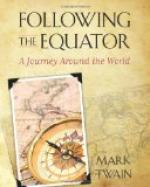The tickets were round-trip ones—to Melbourne, and clear to Adelaide in South Australia, and then all the way back to Sydney. Twelve hundred more miles than we really expected to make; but then as the round trip wouldn’t cost much more than the single trip, it seemed well enough to buy as many miles as one could afford, even if one was not likely to need them. A human being has a natural desire to have more of a good thing than he needs.
Now comes a singular thing: the oddest thing, the strangest thing, the most baffling and unaccountable marvel that Australasia can show. At the frontier between New South Wales and Victoria our multitude of passengers were routed out of their snug beds by lantern-light in the morning in the biting-cold of a high altitude to change cars on a road that has no break in it from Sydney to Melbourne! Think of the paralysis of intellect that gave that idea birth; imagine the boulder it emerged from on some petrified legislator’s shoulders.
It is a narrow-gage road to the frontier, and a broader gauge thence to Melbourne. The two governments were the builders of the road and are the owners of it. One or two reasons are given for this curious state of things. One is, that it represents the jealousy existing between the colonies—the two most important colonies of Australasia. What the other one is, I have forgotten. But it is of no consequence. It could be but another effort to explain the inexplicable.
All passengers fret at the double-gauge; all shippers of freight must of course fret at it; unnecessary expense, delay, and annoyance are imposed upon everybody concerned, and no one is benefitted.
Each Australian colony fences itself off from its neighbor with a custom-house. Personally, I have no objection, but it must be a good deal of inconvenience to the people. We have something resembling it here and there in America, but it goes by another name. The large empire of the Pacific coast requires a world of iron machinery, and could manufacture it economically on the spot if the imposts on foreign iron were removed. But they are not. Protection to Pennsylvania and Alabama forbids it. The result to the Pacific coast is the same as if there were several rows of custom-fences between the coast and the East. Iron carted across the American continent at luxurious railway rates would be valuable enough to be coined when it arrived.
We changed cars. This was at Albury. And it was there, I think, that the growing day and the early sun exposed the distant range called the Blue Mountains. Accurately named. “My word!” as the Australians say, but it was a stunning color, that blue. Deep, strong, rich, exquisite; towering and majestic masses of blue—a softly luminous blue, a smouldering blue, as if vaguely lit by fires within. It extinguished the blue of the sky—made it pallid and unwholesome, whitey and washed-out. A wonderful color—just divine.




